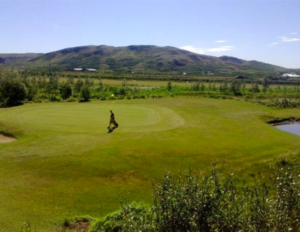Different Strokes: Icelandic Golf Is Quirky, Cold and Surprisingly Fine
November 4, 2014 - 6 minutes read It’s a little past 12 o’clock on the longest day of the year when we finally tee off at a rambling course south of Reykjavik. Our threesome comprises of myself, a fellow from New York and a bloke from London, all of us with a long-standing desire to golf beneath the midnight sun.
It’s a little past 12 o’clock on the longest day of the year when we finally tee off at a rambling course south of Reykjavik. Our threesome comprises of myself, a fellow from New York and a bloke from London, all of us with a long-standing desire to golf beneath the midnight sun.
With more than 60 courses catering to a native population of only 280,000, Iceland boasts the highest number of links per capita of any nation in the world and even more courses per person than American golf hubs like Palm Springs, Maui and San Diego. For about six weeks each summer – from early June to mid July – most of these courses are open around the clock as local duffers and curious foreigners take advantage of the never-ending light.
My own nocturnal frolic unfolds on the most spectacular and perhaps most difficult course on the entire island – Keilir Golf Club. The course is gorgeous and (as we will soon discover) darn hard to play. The extremely challenging front nine is like a frozen version of the Kona Coast, the fairways and greens chiseled from jet-black lava flows. The back nine, on the other hand, is a breezy seaside links course that could easily double as Pebble Beach.
Part of the course was once a zoo and marine park. The stone-lined practice putting green below the club house was once the polar bear enclosure and that weather-beaten metal warehouse astride the ninth fairway (and technically part of the course) is where the killer whale Keiko resided in between stardom in Free Willy and his own release back into the North Atlantic.
Keiler’s 520-yard opening hole is a beast, an undulating fairway flanked by ominous rock walls. Straight away I shank a shot into the lava and count myself lucky to even find the ball. None of us reach the green in less than four strokes. And nobody breaks par. This is just a taste of things to come – Keiler tests both the mental and technical skills of even the best golfers.
The second hole is much shorter – around 320 yards from tee to pin – but even more challenging, the green is protected by lava outcrops with deep crevasses. I play it safe, keeping to the left side of the fairway – longer shots, but less lava. My companions, on the other hand, feeling much more confident, opt for the more direct route – straight over the black stone. Much shorter shot, but no margin for error. The fellow from New York reaches the green with a superb chip. But the bloke from London? Let’s just say that titanium doesn’t stand a chance against volcanic rock – the head of his club, rather than the ball, reached the green in three.
By the fourth hole we have pretty much given up on keeping score and are pondering amongst ourselves how we came to be playing this particular course and how Iceland, against all odds, became such a golf Valhalla.
Nearly every Icelandic city and town boasts its own golf course. Some are challenging, others not, but nearly all of Iceland’s links are thoroughly quirky. The municipal course of Borgarnes, surrounded by pastures and overshadowed by glaciers, features a rather unusual “hazard” between the second and third fairways – a giant red-and-white soda can erected by a local beverage company that’s officially part of the course.
The seaside course near Holmavik, a village renowned for sorcery and witchcraft, sprawls across bluffs decorated with otherworldly scarecrows. And from just about anywhere on the 18-hole Selsvollur Golf Course near Fludir, you can see plumes of steam rising from nearby geysers. During a week roaming around the island, I couldn’t find two courses even remotely the similar.
In a way, Iceland is ready-made for golf. The interior is dominated by ice and lava, but much of the shoreline is rolling, grassy plains. With so few people, there’s loads of vacant land. And it’s relatively cheap by European standards. Trees are a rarity – the Vikings took care of those many moons ago to build their longboats and stoke their hearth fires. Basically all you need to do to launch a simple municipal course is dig a few little holes and plant some flags.
It’s three o’clock in the morning by the time we finish our round at Keiler and retire to the clubhouse terrace. Behind us, the sun is rising over snowcapped volcanic peaks. And looming in the distance, across Faxafloi Bay, is Snaefells Glacier, where Jules Verne set his classic Journey to the Center of the Earth. One of those incredible moments that reinforces your fondness for golf . . . and why you’ve come so many miles to play beneath the midnight sun.
by Joe Yogerst
For more information on Golfing in Iceland, contact, Iceland ProCruises and/or our sister company, Iceland ProGolf!